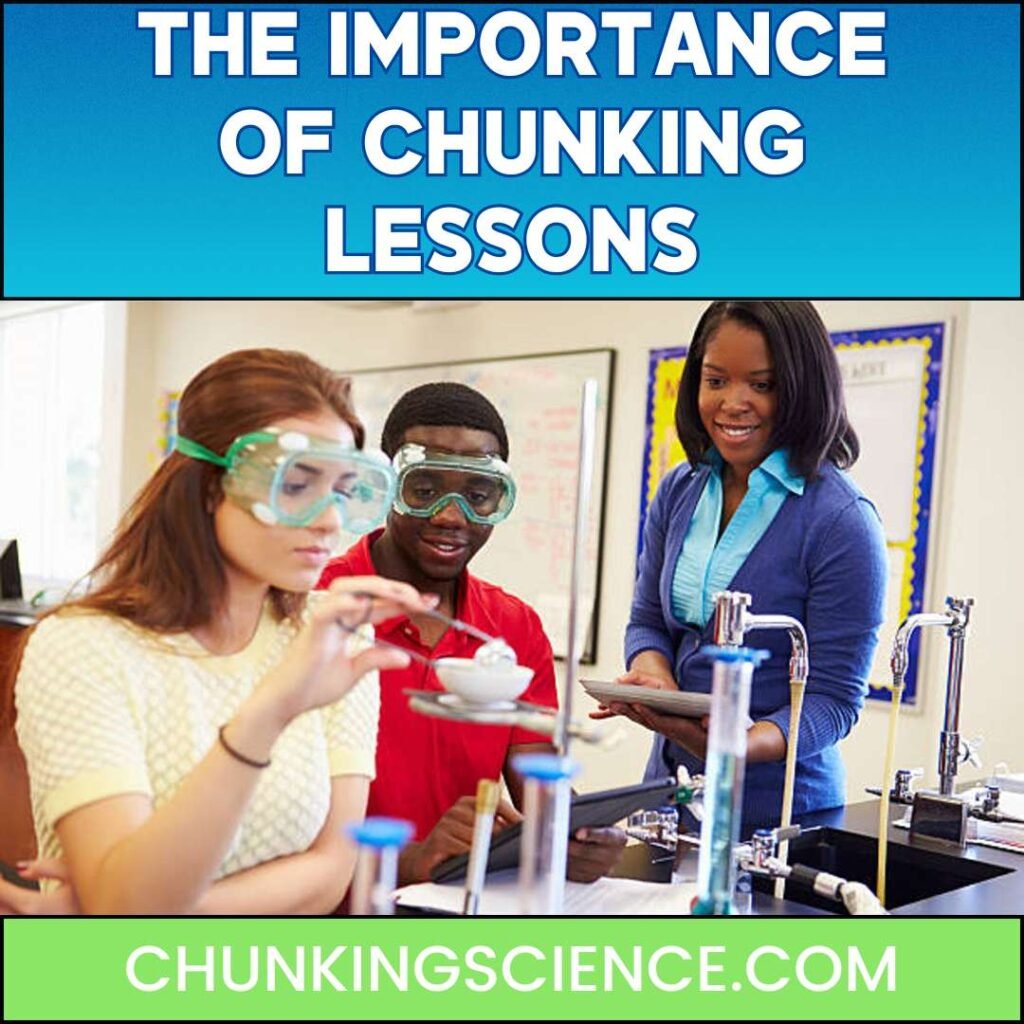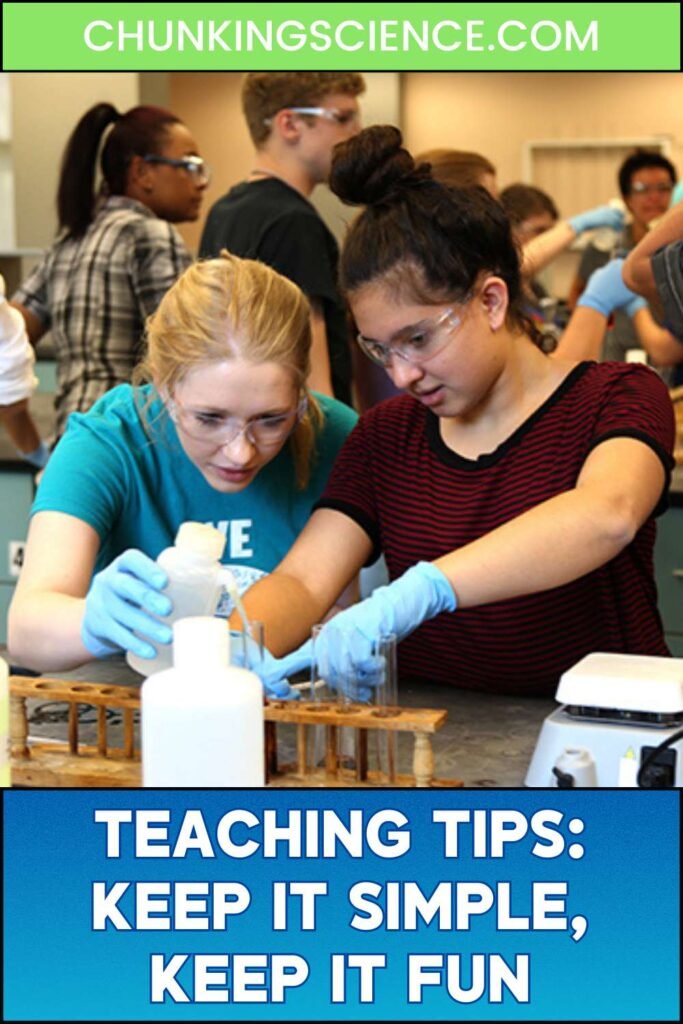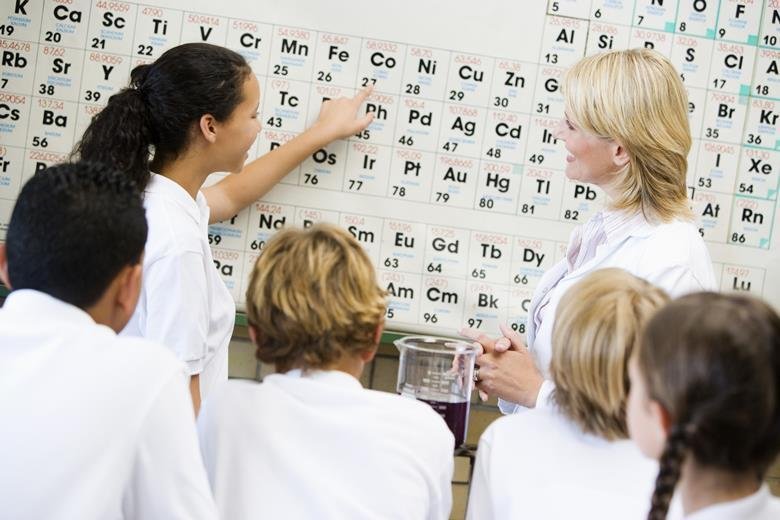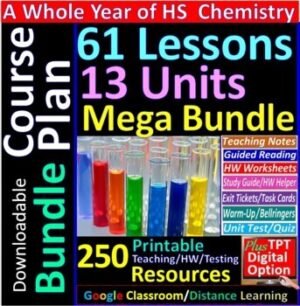Chunking chemistry lessons breaks down topics into smaller pieces, so each lesson becomes easier to teach and for students to understand.
Hey, Fellow Chemistry Teachers!
Ever wondered why I start all my high school chemistry curriculum resources with Types of Matter and the Periodic Table before jumping into the details of Atomic Structure, Chemical Bonding, and Chemical Formulas? It’s not just something I randomly decided — this order is all about setting students up for year-long success in chemistry. It’s all about laying down a solid foundation—getting that big-picture understanding sorted before diving into the tiny, intricate details. Let’s explore why this approach will make learning smoother and more effective for your students.

The Big Picture: Types of Matter and the Periodic Table
Kicking things off with Types of Matter—like elements, compounds, and mixtures—gives students a firm grasp on what they’re dealing with in chemistry. It’s the “what” of the subject, the stuff they encounter in everyday life. Grasping these basics is key because it helps students understand how different materials behave and interact. Here’s how it all connects:
- Elements are pure substances made up of only one type of atom. Understanding this is fundamental when students later learn atomic structure because they already know what these atoms are and how they make up the world around us.
- Compounds are substances formed when two or more elements chemically bond together. Learning about compounds sets the stage for teaching on chemical bonding, showing how atoms come together to create new substances.
- Mixtures are combinations of substances that aren’t chemically bonded. Understanding mixtures helps students grasp the difference between physical and chemical changes, which becomes crucial when they start learning about reactions and formulas.
Once students have a solid grasp of these types of matter, I introduce the Periodic Table—the “map” of chemistry. The Periodic Table isn’t just a list of elements; it’s a powerful tool that organizes all the elements based on their relationships and properties. Here’s why this is so important:
- Organization by Atomic Number: The Periodic Table arranges elements by their atomic number, which is the number of protons in an atom’s nucleus. This helps students understand atomic structure because it shows how the number of protons defines each element.
- Groups and Periods: The table is divided into groups (columns) and periods (rows), highlighting elements with similar properties. For example, elements in the same group often behave and bond in similar ways, which becomes crucial when students start learning about bonding.
- Metals, Nonmetals, and Metalloids: Metals: The table also categorizes elements into metals, nonmetals, and metalloids. This helps students understand why certain elements bond in specific ways and why some are more reactive than others. Additionally, knowing the types and names of elements will be very important in the chemical formula unit when they get into the fun naming rules in nomenclature."
Starting here is essential because this macro understanding sets the stage for everything that comes next. When we move into topics like Atomic Structure, students will already know that an element’s position on the Periodic Table tells us a lot about its atomic makeup—like how many protons it has, how its electrons are arranged, and how it’s likely to bond with other elements.
By beginning with Types of Matter and the Periodic Table, I’m giving students the big-picture framework they need to tackle more detailed topics. This broad understanding allows them to see the connections between what they’re learning now and the more complex ideas they’ll encounter later, like bonding and chemical formulas. It’s like giving them the map before they embark on their chemistry journey, so they’re never lost when they dive into the microscopic world.
Chunking chemistry lessons breaks down topics into smaller pieces, so each lesson becomes easier to teach and for students to understand.
The Importance of Chunking Lessons
Teaching in chunks—breaking down complex topics into manageable pieces—helps students absorb information more effectively. For instance, when teaching Types of Matter, I begin by focusing on elements, then move on to compounds, and finally to mixtures. This way, students can fully grasp each concept before moving on to the next. By the time we get to the Periodic Table, they’re ready to see how these different types of matter are organized and interact.

Hands-On Activities: Making Learning Stick
To really cement these big-picture concepts, I love using hands-on activities. For Types of Matter, I have students sort everyday items into elements, compounds, or mixtures—it’s a simple but effective way to make abstract ideas real. When we move on to the Periodic Table, I get them to create their own mini tables using household items, grouping them by similar properties. These activities don’t just make learning fun; they make it memorable.
Once students have this broad understanding, they’re ready to dive into the micro world of Atomic Structure, Bonding, and Chemical Formulas. And because they’ve already seen how matter behaves on a larger scale, understanding what’s happening at the atomic level becomes much easier.
Chunking chemistry lessons breaks down topics into smaller pieces, so each lesson becomes easier to teach and for students to understand.
Teaching Tips: Keep It Simple, Keep It Fun
- Chunk Your Lessons: Start with the big concepts before diving into details. Break down each lesson into manageable chunks, so students can fully grasp each idea before moving on.
- Use Hands-On Activities: Engage students with activities that bring abstract concepts to life. Sorting items into types of matter or building a mini Periodic Table are great ways to make learning stick.
- Make It Relatable: Connect the material to students’ everyday lives. When they see the relevance, they’re more likely to understand and remember what they’ve learned.

Wrapping It Up
Teaching Types of Matter and the Periodic Table before diving into Atomic Structure, Bonding, and Chemical Formulas isn’t just a smart approach—it’s essential. This method gives students the big-picture understanding they need to succeed in chemistry. By chunking lessons and using hands-on activities, you’ll make learning easier, more engaging, and more effective. So, start big, keep it fun, and watch your students thrive!
Happy teaching! 🧪🔬🎉
-
Chemistry
Unit Plan: Matter, Energy, & Change 5-Lesson Hybrid Bundle ~Distance Learning~
$76.00Original price was: $76.00.$45.00Current price is: $45.00. Buy Now on TPT -
Chemistry
High School Chemistry Year Long Curriculum Bundle -61 Lesson Plans (Digital)
$366.50Original price was: $366.50.$239.00Current price is: $239.00. Buy Now on TPT






